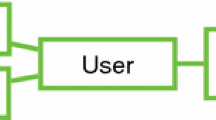Abstract
Peculiarity rules are a new type of useful knowledge that can be discovered by searching the relevance among peculiar data. A main task in mining such knowledge is peculiarity identification. Previous methods for finding peculiar data focus on attribute values. By extending to record-level peculiarity, this paper investigates relational peculiarity-oriented mining. Peculiarity rules are mined, and more importantly explained, in a relational mining framework. Several experiments are carried out and the results show that relational peculiarity-oriented mining is effective.
Similar content being viewed by others
References
Aronis JM, Kolluri V, Foster JP, Buchanan BG (1997) The WoRLd: knowledge discovery from multiple distributed databases, In: Proceedings of the 10th international Florida AI research symposium, pp 337–341
Chen H, Wang FY (2005) Artificial intelligence for homeland security. IEEE Intell Syst 20:12–16
Han JW, Kamber M (2001) Data mining concepts and techniques. Morgan Kaufmann, San Francisco
Kerber R (1992) ChiMerge: discretization of numeric attributes. In: Proceedings of the 9th international conference on artificial intelligence. AAAI, pp 123–128
Lin TY (1998) Granular computing on binary relations 1: data mining and neighborhood systems. In: Polkowski L, Skowron A (eds) Rough sets in knowledge discovery 1. Springer, Berlin, pp. 107–121
Liu C, Zhong N (2001) Rough problem settings for ILP dealing with imperfect data. Comput Intel 17:446–459
Liu H, Lu H, Yao J (1998) Identifying relevant databases for multidatabases mining. In: Proceedings of the 2nd Pacific–Asia conference knowledge discovery and data mining, LNAI 1394, Springer, Berlin, pp 210–221
Liu H, Setiono R (1997) Feature selection via discretization of numeric attributes. IEEE Trans Knowl Data Eng 9:642–645
Muggleton S (1995) Inverse entailment and progol. New Generat Comput 13:245–286
Nienhuys-Chen SH, de Wolf R (1997) Foundations of inductive logic programming, LNAI 1228, Springer, Berlin, pp 163–177
Ohshima M, Zhong N, Yao YY, Murata S (2004) Peculiarity oriented analysis in multi-people tracking images. In: Dai H et al (eds) Advances in knowledge discovery and data mining (PAKDD’04), LNAI 3056, Springer, Berlin, pp 508–518
Quinlan JR (1990) Learning logical definitions from relations. Mach Learn 5:239–266
Quinlan JR, Cameron-Jones RM (1995) Induction of logic programs: FOIL and related systems. New Generat Comput 13:287–312
Ribeiro JS, Kaufman KA, Kerschberg L (1995) Knowledge discovery from multiple databases. In: Proceedings of the 1st international conference on knowledge discovery and data mining. AAAI, pp 240–245
Saso D (2001) Data mining in a nutshell. In: Saso D, Nada L (eds) Relational data mining. Springer, Berlin, pp 3–26
Saso D, Nada L (2001) An introduction to inductive logic programming. In: Saso D, Nada L (eds) Relational data mining. Springer, Berlin, pp 48–73
Skowron A, Rauszer C (1992) The discernibility matrices and functions in information systems. In: Slowinski R (eds) Intelligent decision support. Kluwer, Amsterdam, pp 331–362
Wrobel S (1997) An algorithm for multi-relational discovery of subgroups. In: Komorowski J, Zytkow J (eds) Principle of data mining and knowledge discovery, LNAI 1263, Springer, Berlin, pp 367–375
Wu X, Zhang S (2003) Synthesizing high-frequency rules from different data sources. IEEE Trans Knowl Data Eng 15:353–367
Yao YY (1999) Granular computing using neighborhood systems. In: Roy R, Furuhashi T, Chawdhry PK (eds) Advances in soft computing: engineering design and manufacturing. Springer, Berlin, pp 539–553
Yao YY, Zhong N (2002) An analysis of peculiarity factor in peculiarity oriented data mining. In: Lin TY, Ohsuga S (eds) Proceedings of the 2002 ICDM workshop on foundation of data mining and knowledge discovery (FDM’02). pp 185–188
Yao YY, Zhao Y, Maguire RB (2003) Explanation oriented association mining using rough set theory. In: Proceedings of the 9th international workshop on rough sets, fuzzy sets, data mining, and granular computing, LNAI 2639, Springer, Berlin, pp 165–172
Yao YY, Wang FY, Wang J, Zeng D (2005) Rule + exception strategies for security information analysis. IEEE Intell Syst 20:52–57
Zadeh LA (1997) Toward a theory of fuzzy information granulation and its centrality in human reasoning and fuzzy logic. Fuzzy Sets Syst 90:111–127
Zheng L, Liu C, Dong J, Zhong N (2005) Generating numerical constraints in CILP. Int J Pattern Recogn 19:91–108
Zhong N, Dong JZ, Ohsuga S (2001) Using rough sets with heuristics to feature selection. J Intell Inf Syst 16:199–214
Zhong N, Ohshima M, Ohsuga S (2001) Peculiarity oriented mining and its application for knowledge discovery in amino-acid data. In: Cheung D et al (eds) Advances in knowledge discovery and data mining, LNAI 2035, Springer, Berlin, pp 260–269
Zhong N, Yao YY, Ohshima M, Ohsuga S (2001) Interestingness, peculiarity, and multi-database mining. In: Proceedings of the 2001 IEEE international conference on data mining. IEEE Computer Society, pp 566–573
Zhong N, Yao YY, Ohshima M (2003) Peculiarity oriented multidatabase mining. IEEE Trans Knowl Data Eng 4:952–960
Zhong N, Liu C, Yao YY, Ohshima M, Huang MX, Huang JJ (2004) Relational peculiarity oriented data mining. In: Proceedings of the 2004 IEEE international conference on data mining. IEEE Computer Society, pp 575–578
Zhong N, Motomura S, Wu JL (2005) Peculiarity oriented multi-aspect brain data analysis for studying human multi-perception mechanism. In: Proceedings of the SAINT 2005 workshops (Workshop 8: computer intelligence for exabyte scale data explosion). IEEE Computer Society, pp 306–309
Author information
Authors and Affiliations
Corresponding author
Rights and permissions
About this article
Cite this article
Ohshima, M., Zhong, N., Yao, Y. et al. Relational peculiarity-oriented mining. Data Min Knowl Disc 15, 249–273 (2007). https://doi.org/10.1007/s10618-006-0046-6
Received:
Accepted:
Published:
Issue Date:
DOI: https://doi.org/10.1007/s10618-006-0046-6




